|  
IN THE NEWS | CALENDAR

The rancherias at Trinidad and Blue Lake
are quietly battling for the region's growing gambling market.
Above: an airbrush artist works on a Blue Lake Casino mural
Below right: Workmen complete rock work at Cher-Ae Heights Casino in Trinidad.
story & photos by BOB DORAN
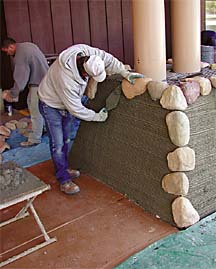 WORK IS ALMOST DONE ON A MAJOR upgrade of Trinidad Rancheria's Cher-Ae WORK IS ALMOST DONE ON A MAJOR upgrade of Trinidad Rancheria's Cher-Ae
Heights Casino, set on a bluff overlooking Trinidad Bay. Meanwhile, over at Blue Lake Rancheria, work is proceeding full-steam ahead on a new gaming facility located off Highway 299. The Blue Lake Casino will employ 300 people and could provide a much-needed shot in the arm to the local economy. It won't be able to compete with the scenic setting of Cher-Ae Heights. But, as it is significantly closer to Arcata and Eureka, it will have the important advantage of convenience. It's a high stakes gamble for both tribes: Trinidad's upscale expansion has set them back almost $7 million, while Blue Lake's new casino is costing about $30 million. How big is the gaming pie the two casinos will be fighting over? No one knows exactly, but according to a 2001 report by the New Orleans-based research firm Urban Systems Inc., the potential market for casinos in the northern Humboldt area could be as much $100 million a year. No one is calling it a war, but a battle is clearly brewing. Cher-Ae Heights 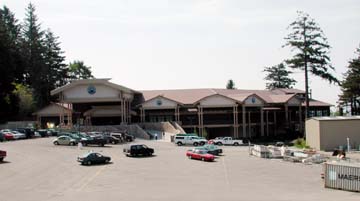 What started in 1988 as "a 20,000 square-foot tilt-up, a tin building" -- as one tribal official put it -- will soon be a 50,000 square-foot facility with a new look, more slots, an expanded bingo room, a bar dubbed the Firewater Lounge and the 200-seat Sunset Restaurant overlooking Trinidad Head. What started in 1988 as "a 20,000 square-foot tilt-up, a tin building" -- as one tribal official put it -- will soon be a 50,000 square-foot facility with a new look, more slots, an expanded bingo room, a bar dubbed the Firewater Lounge and the 200-seat Sunset Restaurant overlooking Trinidad Head.
"We've been in operation for over 14 years and I'm proud to say that we've never closed our doors one time," said Carol Ervin, tribal chairwoman for what is officially known as the Cher-Ae Heights Indian Community of the Trinidad Rancheria. The same cannot be said for a number of California Indian casinos. Many have closed -- some permanently -- due to changes in management or troubles with investment arrangements. Cher-Ae Heights itself has gone through several management teams over the years, although currently the tribal council manages the casino. "We don't have anyone from the outside who comes in to run our business," said Ervin. "If you get outside management and money in, they're the ones who handle everything and the tribe doesn't have a lot to say about what's going on." According to Ervin, the original bingo hall was financed by a small group of investors, who put up $25,000 to $40,000 each for a total of $400,000. Over the course of 14 years that initial investment has generated millions of dollars, particularly since California's Indian gaming rules began allowing coin-fed slot machines.
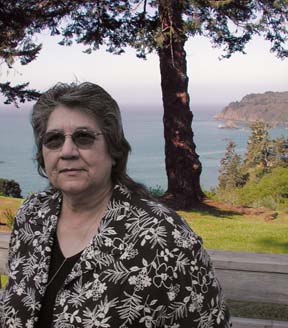 Carol Ervin, tribal chairwoman for the Trinidad Rancheria Carol Ervin, tribal chairwoman for the Trinidad Rancheria
sure and they're not saying. But the report by Urban Systems makes an educated guess; it says Cher-Ae Heights grossed as much as $50 million last year. Where does all that money go? "A lot of it goes back to the winners," said Ervin. "It goes to pay wages, to pay the vendors for the food and supplies, it goes into advertising. It goes back to the community in donations. "And it goes to assist our members. We have a housing fund, an education fund, we pay health insurance, fire insurance. We're developing a social welfare base for our members so that no one will be on public assistance. "I think the bottom line is this: the money does not leave here, it stays in this community." The idea of the remodel was to maintain a natural look on the exterior so the building blends in with the environment. "It's kind of a modernized replication of an Indian house. Then as you get into the interior you'll see more touches of Indian-ness. We didn't want it to be all neon and bubbles shooting in the air.
![[photo of Jack Caza and Eric Bentler]](cover0502-cheraefoodguys.jpg) Cher-Ae Height's Chef Jack Caza on left and Cher-Ae Height's Chef Jack Caza on left and
Food and Beverage Manager Eric N. Bentler.
"I see it as a melding of the old and new. I wanted the Indian people to have pride in it and feel some connection with it; on the other hand I wanted non-Indian people to feel they were welcome too. While there is still work to be done on the building's interior, the restaurant is complete and the exterior upgrade requires only minor finishing touches. "This is it for the expansion," said Ervin. "We don't have a grandiose dream. We're not going to build a 100,000 square-foot building. We're comfortable with what we have. We're going to make it nicer and add more machines. Before we're done I think we'll end up adding about a hundred more machines." It is possible, though, that the tribe may one day build a "destination resort" with accommodations for out-of-town gamblers, Ervin said. "We have a beautiful setting here and we have an empty building here, (since the United Indian Health Service moved to Arcata) and do we want to tear it down?"
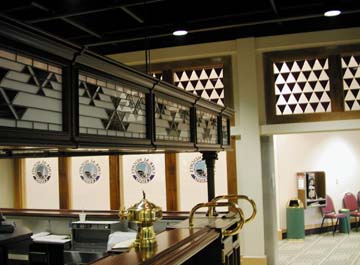 The Firewater Lounge, The Firewater Lounge,
named by tribal elder Joy Sundberg.
A history of competition On the wall behind Ervin's desk are framed art pieces by her cousin, Brian Tripp. Talking about his work, she mentions a piece that hangs in the hallway, a painting with a poem about the brush dance. As talk turns to the importance of the dances, she mentions their competitive nature. "There was always a lot of rivalry. The tribes competed against each other to see who had the best singer, the best dancers and who's going to come out with the strongest regalia. (And even today) they start in the morning and as the day goes on they get more dressed up, more feathers, more color. They get out of the Levis and sweatshirts look. It's a competition." And the competition between the casinos? "I think it will be healthy. It will give people a choice. "Will it have an effect on us?," she continued. "I don't think so. I think they are two different businesses. We have 14 years experience. We're here. We've been here for a long time. We're stable." While Ervin says she feels secure, the report by Urban Systems Inc. suggests she should be concerned. It predicts that once the Blue Lake Casino is up and running, it could draw around 10 percent more revenue than Cher-Ae Heights.
![[inside expanded bingo hall]](cover0502-insideconstruct.jpg) An inside look at the expanded bingo hall under construction. An inside look at the expanded bingo hall under construction.
How much money? Only the tribe knows for The Big Lagoon Rancheria commissioned the report, which concludes that there's room for a third casino on the Humboldt coast. Big Lagoon, a 16-member tribe that owns and operates Hotel Arcata, still holds hopes of entering the gaming business although so far their plans have stalled. Urban Systems suggests that if they did build a casino, they could pull in as much as 18 percent of the region's gaming revenue. While Ervin admits that she does not know all the details of Blue Lake's plans, the big difference she sees between the two casinos is in financing. "We have used local financing with our banks, with Humboldt Bank, Six Rivers Bank, Wells Fargo. We try to keep all of our business right here. "I think Blue Lake has outside investors coming in and I don't know how much say they have about what goes on inside. All you know is what you hear, and we heard there's a big investment group from Las Vegas or someplace that's putting up something like $17 million." Blue Lake Casino
[architectural sketch for entrance to the Blue Lake Casino] 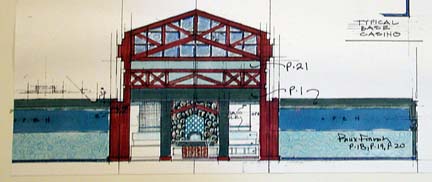 There's only a seed of truth in the rumors Ervin has heard about the casino her neighbors are building 20 miles away on the Blue Lake Rancheria. There's only a seed of truth in the rumors Ervin has heard about the casino her neighbors are building 20 miles away on the Blue Lake Rancheria.
Just as Cher-Ae Heights is managed by the Trinidad Rancheria -- rather than an outside management group -- the casino in Blue Lake will also be managed by the tribe that owns it, the Blue Lake Rancheria. But while Cher-Ae heights was originally built with money provided by a small group of individual investors, the Blue Lake facility is being financed through bank loans guaranteed in part by an Indian casino in Louisiana. In an interview, Blue Lake Casino's chief financial officer Eric Ramos nonetheless emphasized the project's independence. "Many tribes think that the only way they can put together a large deal is to go out and make deals with some Vegas guys or other money guys. That's not the truth." Ramos, who was born and raised in Blue Lake, has a background in finance. He has a business degree from Humboldt State University. After graduation he went into the world of business. "I spent a number of years in Silicon Valley before coming back here. I worked for a `big five' accounting firm, KP&G, for a while, then worked for a couple of start-up companies. When this project came online I ended up coming back." Essentially he returned to help run the family business. "The rancheria is sort of a big family and it's a pretty exciting time for us," he said. In fact, the casino operation's chief executive officer, Arla Ramsey, is Ramos' mother. Jason Ramos, chairman of the tribal gaming commission, is his twin brother. Planning for the casino project started in mid-1999 and construction was begun two years later. An opening date is set for Aug. 1. "With some luck we'll meet it, maybe, maybe not, but that's the date we're aiming at," Ramos said. How big will it be? "The casino is 44,504 square feet (almost as big as the expanded Cher-Ae Heights facility). It has 349 machines and 12 tables with Blackjack, Hi Gal, Let It Ride, Caribbean Stud, those types of card games. Some are poker-based." It's no coincidence that the Blue Lake Casino and Cher-Ae Heights will both end up with 349 slot machines. Why 349? "Under the state gaming compact, tribes that have 349 gaming devices or less are considered non-gaming tribes. Everyone pays a license fee for each machine, but when you go over 349, you also pay a percentage of net win on the machines, and that money goes into a revenue-sharing pool for all of the non-gaming tribes. "Once you go over 349 you are no longer considered a `small tribe' and you don't get to share in the revenue distribution pool. I believe the money also goes to pay for all of the behind-the-scenes work that goes to administer and regulate gaming." Typically tribes that enter the gaming business in a big way will have more than 350 machines. The Hopland Sho-Ka-Wah Casino in Mendocino County, operated by the Hopland Band of Pomo Indians, has more than 700 machines; that's small compared with some Indian casinos in southern California. "In a place like Palm Springs you might find 2,000 machines or more," said Ramos. Of necessity, Blue Lake is starting small. "We have to be kind of conservative because we don't really know what this market is. Our hope and our goal when we came out to build this is that we would have the nicest casino from the Bay Area north." The firm handling construction for Blue Lake Casino is Kitchell Corp., an Arizona-based outfit with a full division dedicated to Native American projects, primarily casinos. "Kitchell only builds top-quality stuff," Ramos claimed. "Not to stereotype them, but there are a lot of Indian casinos out there, especially in California, that are basically metal buildings. "I'm not knocking anyone who built a tin building," he went on in an apparent reference to Cher-Ae Heights' original structure. "We just took a different approach. Instead of putting up the tin structure and building it into an elegant place later on, we're going to come out on the market with something that's really nice right out of the gate." Like Cher-Ae Heights, the Blue Lake Casino will feature a bar -- the Steelhead Lounge -- and an upscale restaurant, the Trillium (prominent Humboldt chef Jean-Louise Hamiche will be running the kitchen). Alice's Restaurant, named for a founding member of the tribe, will offer a buffet, and there will be a fast-food area near the bingo hall. "The bingo hall will be used as a multipurpose room so we can have concerts, boxing, poker events, pool tournaments," Ramos said.
![[photo of Ramos and Frank]](cover0502-alices.jpg) Chief financial officer Eric Ramos and general manager Tom Frank in the Blue Lake Casino's Alice's Restaurant Chief financial officer Eric Ramos and general manager Tom Frank in the Blue Lake Casino's Alice's Restaurant
The tribe raised capital for the casino through a financing arrangement called a "loan syndication" in which a lead bank recruits other banks to put up money for a loan. "The lead bank administers the loan, they collect the interest and principle payments and find a way to perfect their interest in cash," Ramos said. A complicating factor is that the Blue Lake Casino is located on an Indian reservation, which is essentially land held in trust by the federal government. Because it is not legally possible to put a lien on government property, the lead bank would not be able to foreclose on the casino should it fail. That, in part, is why Blue Lake needed another entity -- the Coushatta tribe of Louisiana -- to guarantee the loan. Many tribes avoid the complexities of arranging financing by signing a management agreement with an outside company. For example, the Big Lagoon Rancheria worked on plans with at least two investor groups, including Gaming World, a division of Bally's, the company that operates four Caesar's casinos around the county. In many cases, tribes will turn over operation of the casino to a management firm and just take a percentage of the profits. "You know what?" Ramos said. "Debt service, the cost of money when you go to bank syndication, is not cheap. But the flipside is, when you go with a management group, they want a lot of money, either a percentage or some other fee basis." Ramos said no one from Las Vegas or Atlantic City is involved in the project. Still, the tribe will not run the casino alone. It has hired Tom Frank, a 15-year gaming industry veteran, to be the casino's general manager. As for the Coushatta tribe, they run the Grand Casino near the border with Texas. Ramos said "the Grand" is about 10 times bigger than the Blue Lake Casino. Besides acting as a loan guarantor, the Coushatta will also train Blue Lake's blackjack dealers. Ramos said the Blue Lake tribe is paying a fee (he didn't specify how much) to the Coushatta for the loan guarantee. Blue Lake will also pay a fee for the blackjack training. "You pay for everything in this world now," Ramos said. "It's not easy when you don't have any operating experience and you're trying to shop for $30 million. Fortunately for us, (the Coushatta) stepped up and offered help. "What happens is Indian tribes build their casino and it's profitable, then they look at other businesses. Because they're in the gaming business, it's easy for them to find a strategic partner in another tribe that's building a casino. That's where our partnership came from." Ramos believes the Blue Lake Casino will provide an economic boon -- not only to the tribe but to the surrounding community. "From an economic standpoint the North Coast needs business. People have to work to eat. We're going to hire 300 folks locally. "I don't know if you've noticed, but timber isn't doing real well; there's not a lot of local manufacturing that is doing well. Blue Lake Forest Products, right down the road from us, just went out of business." About the competition from their neighbors? "I think in the end any sort of competition, even if it's between tribes, only helps the customer. Cher-Ae Heights is going to run specials so that the customer can play some other game or do something, and Blue Lake will have to turn around and offer the same special or something better. In the end the spirit of competition will foster a better environment and provide more value to the customer. That sounds clichéd, but it's the truth." | CASINO STATS | | TRINIDAD Cost: $6.5-7 million for upgrade Size: 50,000 sq. ft. (bigger than a football field) Number of slots: 240 Bingo room: seats 800 Restaurants: Sunset Restaurant and a "snack bar" Employees: 200 in casino, 390 on tribal payroll w/ Seascape and North Coast Inn Opening date: scheduled for June 1 Members in tribe: 99 | BLUE LAKE Cost: about $30 million for new facility Size: 44,504 sq. ft. (bigger than a football field) Number of slots: 349 Bingo room: seats 456 Restaurants: The Trillium, Alice's Restaurant and a "fast food operation" Employees: 350+ Opening date: Aug. 1 Members in tribe: 51 |
IN THE NEWS | CALENDAR Comments? E-mail the Journal: [email protected] 
© Copyright 2002, North Coast Journal, Inc. | 

 WORK IS ALMOST DONE ON A MAJOR upgrade of Trinidad Rancheria's Cher-Ae
WORK IS ALMOST DONE ON A MAJOR upgrade of Trinidad Rancheria's Cher-Ae What started in 1988 as "a 20,000 square-foot tilt-up, a tin building" -- as one tribal official put it -- will soon be a 50,000 square-foot facility with a new look, more slots, an expanded bingo room, a bar dubbed the Firewater Lounge and the 200-seat Sunset Restaurant overlooking Trinidad Head.
What started in 1988 as "a 20,000 square-foot tilt-up, a tin building" -- as one tribal official put it -- will soon be a 50,000 square-foot facility with a new look, more slots, an expanded bingo room, a bar dubbed the Firewater Lounge and the 200-seat Sunset Restaurant overlooking Trinidad Head. Carol Ervin, tribal chairwoman for the Trinidad Rancheria
Carol Ervin, tribal chairwoman for the Trinidad Rancheria![[photo of Jack Caza and Eric Bentler]](cover0502-cheraefoodguys.jpg) Cher-Ae Height's Chef Jack Caza on left and
Cher-Ae Height's Chef Jack Caza on left and  The Firewater Lounge,
The Firewater Lounge, ![[inside expanded bingo hall]](cover0502-insideconstruct.jpg) An inside look at the expanded bingo hall under construction.
An inside look at the expanded bingo hall under construction. There's only a seed of truth in the rumors Ervin has heard about the casino her neighbors are building 20 miles away on the Blue Lake Rancheria.
There's only a seed of truth in the rumors Ervin has heard about the casino her neighbors are building 20 miles away on the Blue Lake Rancheria.![[photo of Ramos and Frank]](cover0502-alices.jpg) Chief financial officer Eric Ramos and general manager Tom Frank in the Blue Lake Casino's Alice's Restaurant
Chief financial officer Eric Ramos and general manager Tom Frank in the Blue Lake Casino's Alice's Restaurant